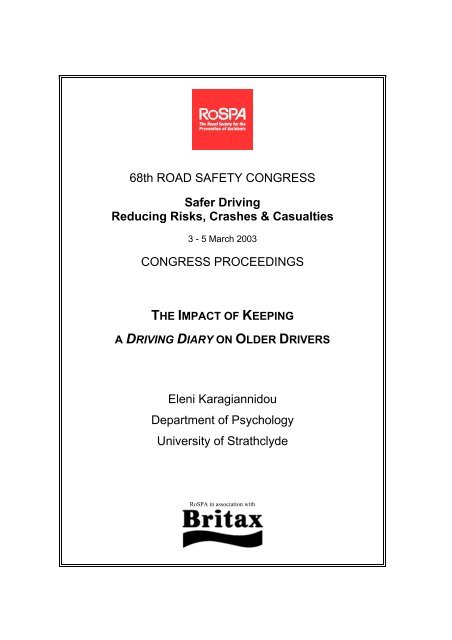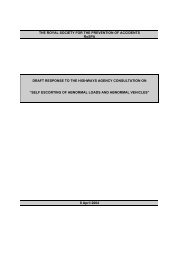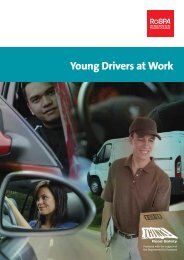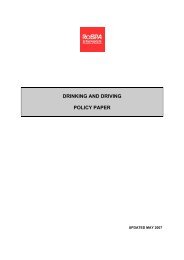Eleni Karagiannidou - RoSPA
Eleni Karagiannidou - RoSPA
Eleni Karagiannidou - RoSPA
Create successful ePaper yourself
Turn your PDF publications into a flip-book with our unique Google optimized e-Paper software.
68th ROAD SAFETY CONGRESS<br />
Safer Driving<br />
Reducing Risks, Crashes & Casualties<br />
3 - 5 March 2003<br />
CONGRESS PROCEEDINGS<br />
THE IMPACT OF KEEPING<br />
A DRIVING DIARY ON OLDER DRIVERS<br />
<strong>Eleni</strong> <strong>Karagiannidou</strong><br />
Department of Psychology<br />
University of Strathclyde<br />
<strong>RoSPA</strong> in association with
<strong>RoSPA</strong> Road Safety Congress 3 - 5 March 2003<br />
“The Impact of Keeping a Driving Diary on Older Drivers”<br />
<strong>Eleni</strong> <strong>Karagiannidou</strong><br />
University of Strathclyde<br />
THE IMPACT OF KEEPING A DRIVING DIARY ON OLDER DRIVERS<br />
<strong>Eleni</strong> <strong>Karagiannidou</strong><br />
&<br />
Hugh Foot<br />
University of Strathclyde<br />
Department of Psychology, University of Strathclyde<br />
Introduction<br />
Populations of elderly people have been growing steadily in western societies. According to<br />
the statistics of the Office for National Statistics, for 2000, the over 60’s consisted 20.4% of<br />
the total population, though over 65’s consisted 15.59% of the total population of the U.K.. In<br />
addition, a Help the Aged report estimates that by 2021, 1 in 3 people in the UK will be aged<br />
over 60.<br />
This increase is mainly due to lower birth rates as well as increased longevity and is followed<br />
by a rise in the driving populations of older people. Driving is a major means of mobility in<br />
this population. The growing need for mobility reflects the great importance it plays in the<br />
lives of older people. Mobility is related to greater life satisfaction and is an important<br />
contributor to perceived quality of life. Driving is a complex task, and requires the coordination<br />
of several psycho-motor functions. For example, some of the physical and mental<br />
functions that are used when driving are eyesight and hearing (for the recognition of<br />
environmental situations), judgment (judgment of the situations -which is a multi-dimensional<br />
function) and reaction (a course of action taken based on the judgments made).<br />
Ageing brings cognitive, perceptual, functional and psychomotor limitations (such as, vision,<br />
attention, perception, memory, decision-making, reaction time and physical fitness), which<br />
may be accompanied by medical conditions that impair driving. The functional limitations<br />
caused by these, and quite often the medication used to treat them, result in deteriorating<br />
driving abilities.<br />
<strong>RoSPA</strong> Road Safety Congress 2003 Page 1 of 9
<strong>RoSPA</strong> Road Safety Congress 3 - 5 March 2003<br />
“The Impact of Keeping a Driving Diary on Older Drivers”<br />
<strong>Eleni</strong> <strong>Karagiannidou</strong><br />
University of Strathclyde<br />
Despite the fact that for many occasion the level of impairment on the driving task has not yet<br />
been identified, as people grow older their ability to drive a car safely may be compromised<br />
and ageing may be accompanied by “riskier” driving. This is revealed by elderly people’s<br />
accident involvement. Research has revealed that when mileage is taken into account the<br />
risk of being injured in traffic is higher for drivers over 65, compared to driving in the 25-64<br />
age band.<br />
In all these traffic accidents, the human as well as the financial costs are issues that require<br />
careful consideration. According to the Road Accidents Scotland 2001 report, the average<br />
cost per casualty for the U.K. in 2001 prices is between £1,194,240 (fatalities), £134,190<br />
(serious injuries), and £10,350 (slight injuries). These figures include lost output,<br />
medical/ambulance, pain/grief/suffering, police/administration, and damage to property costs.<br />
Recognising the effect of ageing on driving performance, policies have been developed in<br />
many countries. In the U.K. there is the requirement of a medical record signed by the driver,<br />
when completing the 70 th year of age, and every 3 years thereafter. In other countries, it is up<br />
to the older person’s physicians or GP to decide whether their clients are capable to continue<br />
driving. Still other countries have introduced medical assessments and/or road tests. The<br />
large deviation of laws and policies between different countries reveals that it is not quite<br />
clear yet what constitutes an appropriate assessment of fitness to drive. Taking into account<br />
the increase in the projected number of elderly drivers and in their accident rates, it becomes<br />
obvious that more research is needed on these issues.<br />
Many older drivers are aware of their failing capacities and the impact on their driving<br />
performance.<br />
<strong>RoSPA</strong> Road Safety Congress 2003 Page 2 of 9
<strong>RoSPA</strong> Road Safety Congress 3 - 5 March 2003<br />
“The Impact of Keeping a Driving Diary on Older Drivers”<br />
<strong>Eleni</strong> <strong>Karagiannidou</strong><br />
University of Strathclyde<br />
To diminish the difficulties they face they may ‘compensate’ for their deteriorating abilities by<br />
adapting self-limiting and self-regulating techniques: in other words, limiting their driving to<br />
only those situations they feel comfortable driving under. When they feel psychological<br />
ready, they eventually give up driving altogether. Nonetheless, others are not aware of the<br />
limitations which they incur progressively and very slowly, and others are unwilling to admit<br />
any deterioration (e.g., those who have no alternative transportation). There may of course<br />
be psychological factors, such as reduced confidence, which may result in quitting driving<br />
prematurely.<br />
The difference in older drivers’ perceptions about when they will limit or stop driving may<br />
reflect a difference in self-awareness. Previous research has shown that the higher their<br />
mileage the more likely older people were to rate themselves as being better drivers than<br />
their peers. However, other research findings reveal that on-road driving performance and<br />
history of adverse driving events are not related to drivers’ ratings of self-confidence. These<br />
discrepancies may reflect lack of awareness. In addition, other research has revealed that<br />
older drivers think they will be the first to know when they should stop driving, and that many<br />
of them have not considered the possibility that they may not realise when it is time for them<br />
to quit driving. The present research was designed to uncover differences in self-awareness.<br />
Present study<br />
Although age-related impairment may increase risk, self-awareness and the use of selfprotective<br />
behaviours (e.g., driving slower) can confound the relationship between risk and<br />
involvement in adverse driving events, by reducing exposure to them. In the present study,<br />
factors that contribute to becoming psychologically ready to engage in self-protective<br />
behaviours were investigated, as were the ways in which senior citizens interact with the<br />
traffic environment. The theoretical models that were utilised in the present study were the<br />
models of Health Behaviour & Self-protective Behaviours, known as value-expectancy<br />
models or Social Cognition Models. One of the main objectives of the current study was to<br />
raise older drivers’ self-awareness through self-monitoring, and encourage the adoption of<br />
self-protective behaviours and the avoidance of risky situations<br />
<strong>RoSPA</strong> Road Safety Congress 2003 Page 3 of 9
<strong>RoSPA</strong> Road Safety Congress 3 - 5 March 2003<br />
“The Impact of Keeping a Driving Diary on Older Drivers”<br />
<strong>Eleni</strong> <strong>Karagiannidou</strong><br />
University of Strathclyde<br />
The study was conducted in four stages: a) Focus groups, which were exploratory and the<br />
findings of which were used in order to identify the main themes to be investigated and to<br />
construct the consequent measures; b) Driving Experiences Questionnaire (DEQ), an<br />
extensive questionnaire (pre-test), which explored, among other issues, older people’s<br />
driving history, experiences, difficulties and stresses, self-reported accidents, and selfperceptions<br />
about their health and driving; c) Driving Diary (DD), that is a diary of 30<br />
consecutive journeys that was designed to raise older drivers’ self-awareness by monitoring<br />
their day-to-day driving performance; unique information on traffic exposure of elderly drivers<br />
was also obtained by the DD; d) and finally, the Post-Diary Questionnaire (PDQ), that was<br />
designed to capture direct and indirect measures of changes on driving performance,<br />
awareness, and confidence (post-test).<br />
A total of 221 drivers of drivers aged between 56.5 and 88 years of age (mean age=70.6,<br />
sd=6.2) completed the DEQ. Of these, 61, 34 men and 27 women, completed the DD (mean<br />
age=72.2, sd=5.8). The PDQ was completed by 154 drivers, who were the “diary group” and<br />
a further 93 in the “non-diary” group, a sub-sample that consisted of 52 men and 41 women<br />
(mean age=69.4,sd=6.1). In relation to demographic characteristics of the sample: 64.5%<br />
were married, 85.5% were retired or unemployed, 63% were living in town suburbs, 93%<br />
were living in a private house, 35.3% had completed only compulsory education, while the<br />
remaining went further in education, and finally, 44.7% had a monthly income of £500-1000.<br />
In relation to their driving, all but 3 participants were still drivers (three had quitted less than 6<br />
months ago), and all but three were experienced, with driving experience for over 15 years.<br />
Very few of them (8%) have been professional drivers.<br />
Results<br />
DEQ Results<br />
The results from the DEQ concern the whole sample of 221 drivers. In relation to their health<br />
status, the mean number of conditions reported by the drivers was 0.9, with 45% of the<br />
sample being condition-free. Among the most prevalent conditions reported were: arthritis or<br />
fall (significant), hearing and vision impairment. It was found that the older the person the<br />
more likely they were to report these conditions. The vast majority (90.5%) of the drivers<br />
reported that their health conditions had not affected their driving. Only 21 drivers reported<br />
that some of their health conditions (vision, arthritis, diabetes mellitus, hypertension, sleep<br />
disorder) had affected their driving performance.<br />
<strong>RoSPA</strong> Road Safety Congress 2003 Page 4 of 9
<strong>RoSPA</strong> Road Safety Congress 3 - 5 March 2003<br />
“The Impact of Keeping a Driving Diary on Older Drivers”<br />
<strong>Eleni</strong> <strong>Karagiannidou</strong><br />
University of Strathclyde<br />
Turning into driving-related finding, older drivers drove mostly for social-related purposes<br />
(96.5% of the sample reported that), in order to complete everyday errands (95%) and some<br />
drove for medical appointments (60% of the sample).<br />
It was generally found that men drove more miles and more hours than women. When asked<br />
how their driving abilities were in relation to when they were younger, 80.2% reported their<br />
abilities were good or excellent and for the comparison with other people of their age, 87.1%<br />
said again that their driving was good or excellent. However, half of the sample (50.3%)<br />
reported that they expect their driving to be only fair or good in the future.<br />
Findings in relation to traffic incidents and accidents revealed that 9.6% of the sample was<br />
involved in at least one major accident in the past 2-3 years, 24% in at least one minor<br />
accident and 57% in at least one near miss. In addition, men and ‘younger’ older drivers<br />
reported more near misses than women and ‘older’ older drivers, respectively. Further<br />
analysis revealed that the older the person, the fewer the reported near misses, but the more<br />
the minor accidents and the reported stress. Also, drivers who reported major accidents were<br />
more likely to report at least one minor accident as well. In addition, the better the selfreported<br />
driving abilities the fewer the minor accidents reported; however, self-reported<br />
driving abilities did not correlate with major accidents or near misses<br />
The reasons that older drivers would consider quitting driving were analysed: doctor’s advice<br />
or medical assessment (95.9% of the sample reported this reason), deteriorated health<br />
(81.4% of the sample), loss of their confidence (80%), car being unavailable (77.6%),<br />
feelings of nervousness or uneasiness (56.4%), no need to drive any more (48.7%), family’s<br />
or friends’ advice (47.6%), and a traffic accident or incident (28.3% of the sample reported<br />
this reason). Women were more likely to report an accident/incident as a reason, and<br />
‘younger’ older drivers were more likely to report that family’s or friends’ advice would<br />
contribute to their decision to quit driving some time in the future, more than ‘older’ older<br />
drivers.<br />
<strong>RoSPA</strong> Road Safety Congress 2003 Page 5 of 9
<strong>RoSPA</strong> Road Safety Congress 3 - 5 March 2003<br />
“The Impact of Keeping a Driving Diary on Older Drivers”<br />
<strong>Eleni</strong> <strong>Karagiannidou</strong><br />
University of Strathclyde<br />
With regard to the self-reported stress under various driving situations, results showed that<br />
‘finding that other drivers in front of you’, ‘driving on wet or icy roads’, and driving ‘unfamiliar<br />
routes’ were the most stressful situations, reported by 75.9%, 73.5% and 71.8% of the<br />
drivers, respectively. In addition, driving ‘in a hurry’, ‘in heavy traffic’, coming across<br />
‘unfamiliar signs’, and ‘switching lanes in heavy traffic’, were also stressful, and were<br />
reported by 66.6%, 65.4%, 62.1% and 59.4% of the drivers, respectively. Furthermore,<br />
results showed that women generally reported more stress than men, and especially when:<br />
‘switching lanes in heavy traffic’, ‘finding that drivers in front of you suddenly brake’, ‘driving<br />
on wet or icy roads’, ‘dealing with unfamiliar signs’, ‘driving somebody else's car’, and<br />
‘parking on busy roads with limited parking space’. Moreover, ‘older’ older drivers reported<br />
higher stress when driving on wet or icy roads, but lower stress when dealing with unfamiliar<br />
signs than ‘younger’ older drivers.<br />
Among the potentially risky situations that drivers now frequently avoided were: driving when<br />
feeling tired or sleepy or ill, at rush hours, under adverse weather conditions, long distances,<br />
parking on busy roads or narrow spaces. They also sometimes avoided driving: at night,<br />
when somebody else is driving, unfamiliar routes at junctions and on motorways. It was also<br />
found that women and ‘older’ older drivers more often avoided driving: on motorways, at<br />
junctions and complicated crossroads, unfamiliar routes, parking in busy roads or narrow<br />
spaces (women); under adverse weather conditions (both women and ‘older’ older drivers);<br />
under poor lighting conditions, at rush hours and long distances (‘older’ older drivers).<br />
PDQ Results: the Diary and the Non-Diary Groups<br />
In relation to the avoidance of risky situations in the DEQ and the PDQ from both the diary<br />
and the non-diary groups, some significant differences were found. More specifically, drivers<br />
in the diary group avoided driving at rush hours, when tired/sleepy/ill, parking in busy roads<br />
and narrow spaces, and driving at night less frequently in the PDQ, than in the DEQ, and<br />
these were all significant differences. (For the non-diary group only driving at rush hours and<br />
driving when tired/sleepy/ill produces significant differences in the DEQ and PDQ.)<br />
<strong>RoSPA</strong> Road Safety Congress 2003 Page 6 of 9
<strong>RoSPA</strong> Road Safety Congress 3 - 5 March 2003<br />
“The Impact of Keeping a Driving Diary on Older Drivers”<br />
<strong>Eleni</strong> <strong>Karagiannidou</strong><br />
University of Strathclyde<br />
In addition, regarding the experienced stress under various situations, the diary group<br />
reported more stress in the PDQ for all the following situations: having conversations with<br />
passengers, driving in a hurry, driving somebody else’s car, parking in a multi-storey car park<br />
with limited space, coming across unfamiliar signs, and finding that other drivers in front of<br />
you suddenly brake. Only for one situation, keeping up with the speed of other drivers, the<br />
self-reported stress decreased.<br />
It was also found that, after the diary, drivers’ confidence in relation to how it was when they<br />
were younger decreased. However, their beliefs of being more skilful than their peers<br />
became stronger. Furthermore, in relation to how drivers that kept the diary and those that<br />
did not rated their driving abilities before and after the diary, the following were found:<br />
judgment of driving abilities in relation to peers was similar for both groups in the DEQ and<br />
PDQ, with the diary group reporting slightly higher ratings. However, self-perceived driving<br />
abilities in relation to how they were in the past, were significantly weakened after the diary,<br />
and the diary group this time reported slightly lower ratings than the non-diary group.<br />
Furthermore, regression analysis was used to identify the factors that may predict avoidance<br />
of potentially risky situations. Some preliminary results revealed that self-reported stress,<br />
self-perceived driving abilities and age were all independent predictors of avoidance. When<br />
different predictors were used in another model, perceived likelihood of accident<br />
involvement, feelings of being at risk when driving and difficulties in specific driving situations<br />
emerged as important factors that predict avoidance of potentially risky driving situations.<br />
Finally, qualitative findings in relation to whether participants in the diary group perceived any<br />
differences in their driving after they kept diary revealed that drivers perceived changes in<br />
specific driving-related skills and abilities (“I feel that I have improved entering roundabout<br />
junctions”), and those concerning reaction times (“I’m facing the fact that I’m getting older<br />
and that time is the enemy”), and attention (“I think I’m more aware that I’m an older driver<br />
and as such I must give all my attention to my driving”;). They also reported changes in their<br />
hazard-perception (“I am more aware of the hazards”), and general awareness (“Before<br />
...when I had a near miss I’d be glad nobody was hurt and forget it. Now, when there is an<br />
incident, I analyse it to see who had made the error in judgment….”; “I have paid more<br />
attention to the mechanisms of driving and driving behaviours…”).<br />
<strong>RoSPA</strong> Road Safety Congress 2003 Page 7 of 9
<strong>RoSPA</strong> Road Safety Congress 3 - 5 March 2003<br />
“The Impact of Keeping a Driving Diary on Older Drivers”<br />
<strong>Eleni</strong> <strong>Karagiannidou</strong><br />
University of Strathclyde<br />
Conclusions<br />
Due to fact that disparity in the driving performance increases with age, the investigation of<br />
the role of health conditions in driving performance and the identification and development of<br />
reliable medical assessments and on-road tests becomes even more difficult. However, the<br />
investigation of role of the drivers themselves may be promising, as it is focused on the<br />
individual needs and limitations. The ‘intervention’ method, the DD, used in the present study<br />
was theory-driven, designed to manipulate cognitive constructs within the Theoretical Models<br />
of Health Behaviours. The aim was to make it a useful tool for increasing the awareness of<br />
the drivers, as well as the sense of personal susceptibility. Increasing self-awareness by<br />
monitoring driving behaviours through the DD, appears to lead to the engagement in selflimiting<br />
driving behaviours, and this in turn, may reduce risk through reducing exposure on<br />
‘risky’ situations.<br />
It appears that many older people are sensitive to their visual and other deficits. The majority<br />
of the drivers in the present study reported that deteriorated health would contribute to their<br />
decision to quit driving. Moreover, the avoidance of potential risky situations appeared to<br />
differentiate between drivers of different age. Thus, helping older drivers realise how their<br />
health conditions and their functional limitations may impair driving, may influence their<br />
decision-making.<br />
Social-related purposes was the most frequently reported reason for driving. In the present<br />
study, the diary provided the drivers with the opportunity to think over individual driving<br />
journeys. Drivers monitored and reported not only on the difficulties and stress they<br />
experienced, but also on the importance and need for driving. Helping individual drivers<br />
recognise whether there is a real need for driving, may also influence their decision-making<br />
about driving.<br />
It has been found that, drivers with dementia overestimate their capabilities and may not<br />
restrict their driving, thus, may not ‘compensate’ for their failing abilities, as they are not<br />
aware of their limitations. Thus, the use of the driving diary as a way of monitoring one’s<br />
behaviours should be expanded in order to include individuals who may have reduced<br />
abilities of self-monitoring. In relation to this, the role of social support networks, should be<br />
investigated further.<br />
<strong>RoSPA</strong> Road Safety Congress 2003 Page 8 of 9
<strong>RoSPA</strong> Road Safety Congress 3 - 5 March 2003<br />
“The Impact of Keeping a Driving Diary on Older Drivers”<br />
<strong>Eleni</strong> <strong>Karagiannidou</strong><br />
University of Strathclyde<br />
Furthermore, some older drivers may be more reluctant to reduce their driving under high–<br />
risk situations, for example those who live alone and have no alternative transportation. In<br />
fact, reports from older drivers’ focus groups consistently indicate that when there is no<br />
choice but to drive to get to doctor appointments, or to complete everyday errands, they will<br />
do so. Thus, although recognition of one’s limitations is one of the basic steps in order to<br />
enhance safety, it is deemed to fail if it is not coupled with the use of means that provide<br />
sufficient transportation resources to those older populations that need them the most.<br />
On the other hand, reducing driving when in fact one is still fit to drive, may lead to<br />
deterioration of driving skills. In the present study, women generally reported more stress<br />
and less confidence in their driving, and more avoidance of various driving situations. This<br />
may be related to the finding from other research that shows an increase in the population of<br />
female older drivers, who mostly rely on their partners, until they take up driving when the<br />
need arises, for example in the event that their partner is not fit to drive any more.<br />
Restricted mobility among older people has been found to be related with the onset or<br />
acceleration of adverse health outcomes, such as depression, even when accounting for<br />
socio-demographic and health-related factors. Therefore, enhancing the self-awareness and<br />
preserving the self-esteem of these individuals, may enhance the well-being of older<br />
populations.<br />
In conclusion, the role of driving diaries should be expanded to include individuals with a<br />
wider range of abilities and limitations. In addition, further ways to increase the selfawareness<br />
should be explored. These endeavours should be tailored to the individual’s<br />
needs and should be accompanied by alternative transportations that preserve the<br />
independent functioning and retain the dignity and self-esteem of the senior citizens.<br />
<strong>RoSPA</strong> Road Safety Congress 2003 Page 9 of 9

















